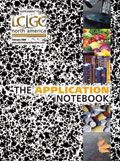Application of a GPC-LC–MS/MS Method for the Determination of 31 Mycotoxins in Edible OIls
The Application Notebook
Gel Permeation Chromatography (GPC) is widely used for sample clean up in mycotoxin analysis. The most commonly described methods use GPC columns packed with SX-3 BioBeads suitable for cleaning Zearalenone, Aflatoxins, and Trichothesenes from edible oils and fatty matrices. Separation of Fumonisins from the oil fraction are inadequate with this column.
Gel Permeation Chromatography (GPC) is widely used for sample clean up in mycotoxin analysis. The most commonly described methods use GPC columns packed with SX-3 BioBeads suitable for cleaning Zearalenone, Aflatoxins, and Trichothesenes from edible oils and fatty matrices. Separation of Fumonisins from the oil fraction are inadequate with this column.
The new GPC column designed by LCTech shows superior performance for simultaneous clean up of Zearalenone, Trichothesenes (types A, B and D), Aflatoxins, Ochratoxin A, including Fumonisins, along with other Mycotoxins from edible oil.
Method development
Different column materials and compositions have been tested. Variations of parameters including eluent composition, pH, and temperature have all been optimized to provide ideal separation of target analytes from the edible oil matrix. Method parameters were tested by direct GPC-MS/MS, and the separation of the analytes from the oil was satisfactory up to oil concentrations of 0.1g.mL THF (Figure 1).

Figure 1: Chromatogram (direct GPC-MS/MS coupling) of maize oil (0.1 g/1 mL THF) spiked with a multi-mycotoxin mix.
Influence of water content
Variation of the water content of the eluent had a remarkable influence on the retention times of the fumonisins but had little effect on other toxins. Eluent containing 10 % of water provided good separation but increasing water content to 20 % caused coelution of fumonisins with the oil fraction.
Influence of pH
Variation of the pH of the eluent (0.2, 1.0, and 2.0 % formic acid) influenced the retention of fumonisins, but not of the other toxins. Best results were obtained with 1 % formic acid. Higher acid content improved peak symmetry but F± and FB2 coeluted with the oil fraction.
Method parameters and performance
The new GPC column allows good separation of the oil and analytes (Figure 1). The toxins were measured by a LC–MS/MS multi-mycotoxin method with ESI ± ionization. The recoveries obtained with the combined GPC-LC–MS/MS method ranged between 74 and 104 % with RSD less then 5 % (Figure 2). For some analytes, low matrices suppression effects were observed. The limits of quantitation complied with the maximum levels for analytes regulated by the EC (1881/2006).

Figure 2: Recoveries from spiked corn oil for different groups of mycotoxins obtained with the final GPC-LCâMS/MS method.
References
(1) Hetmanski, M. T., Scudamore, K. A., 1989. "A simple quantitative HPLC method for determination of aflatoxins in cereals and animal feedstuffs using gel permeation chromatography clean-up." Food Add Contam, 6, 35–48.
(2) Ranfft, K., Gerstl, R., Mayer, G., 1990. "Determination of occurrence of zearalenone in cereals and mixed feeds." Z Lebensm Unters Forsch, 191, 449–453.
(3) Dunne, C., Meaney, M., Smyth, M., Tuinstra, L. G., 1993. "Multimycotoxin detection and clean-up method for aflatoxins, ochratoxin and zearalenone in animal feed ingredients using high-performance liquid chromatography and gel permeation chromatography." J Chromatogr, 629, 229–235.
(4) Kappenstein, O., Klaffke, H., Mehlitz, I., Tiebach, R., Weber, R., Lepschy, J., Wittkowski, R., 2005. "Determination of zearalenone in edible oils with SEC and LC-ESI-MS/MS." Mycotoxin Research, 21, 3–6.
(5) Kocher, U., 2006. "Multimethode zur Bestimmung von Mykotoxinen in Speiseölen mittels LC-MS/MS." Conferfence transcript 28th Mycotoxin-Workshop, Bydgoszcz, Poland, May 29–31.

Pickering Laboratories, Inc.
1280 Space Park Way, Mountain View, CA 94043
Email: sales@pickeringlabs.com
Website: www.pickeringlabs.com


.png&w=3840&q=75)

.png&w=3840&q=75)



.png&w=3840&q=75)



.png&w=3840&q=75)














